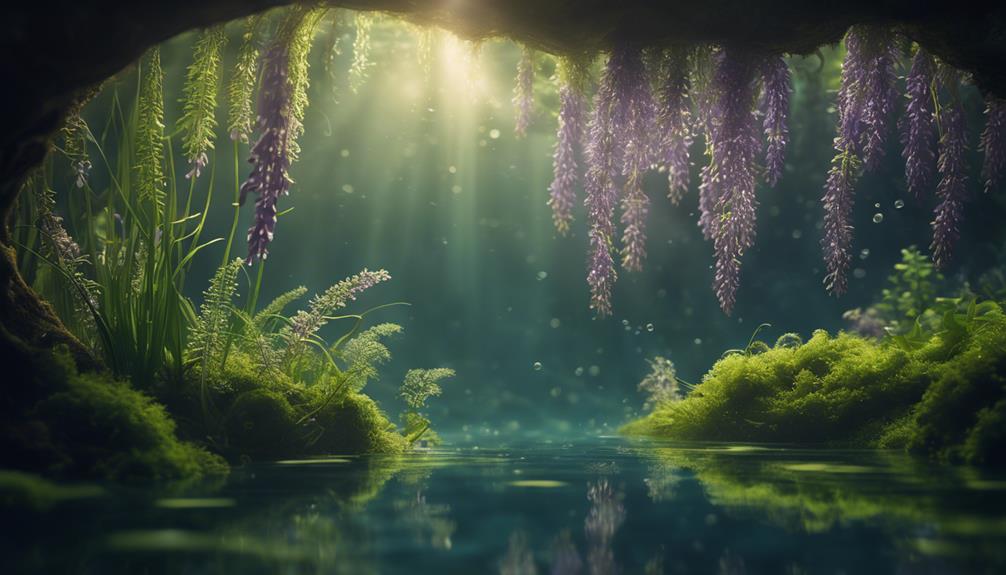In an aquatic life support system, you're only as successful as the plants that thrive within it, as they play a vital role in maintaining water quality, providing a habitat for aquatic life, and creating a self-sustaining ecosystem. Leafy greens like lettuce, kale, and spinach are ideal for beginners, with low nutrient requirements and ability to thrive in smaller systems. Fruiting plants like tomatoes, peppers, and cucumbers have higher nutrient demands and are better suited for larger systems with more mature ecosystems. By understanding the specific needs of these plants, you'll be well on your way to creating a harmonious and thriving aquatic environment – and there's more to explore on this journey.
Table of Contents
Key Takeaways
- Leafy greens like lettuce, kale, and spinach are ideal for beginners due to their low nutrient requirements and ability to thrive in smaller systems.
- Fruiting plants like tomatoes, peppers, and cucumbers have higher nutrient demands and are better suited for larger systems with more mature ecosystems.
- Plants with robust root systems, like kale, can anchor themselves in grow beds, while others require more support to thrive in aquatic life support systems.
- Tomatoes require specific conditions to thrive, including pH between 5.5-6.5, temperatures between 65°F-85°F, and high nutrient levels in aquatic life support systems.
- Regular pruning and monitoring of plant health, nutrient levels, and water quality are crucial to ensure a balanced and thriving aquatic life support system.
Understanding Aquaponics Basics
Get ready to plunge into the world of aquaponics by understanding how this innovative system works, where fish, plants, and bacteria collaborate in a symbiotic relationship to create a thriving ecosystem.
As you embark, you'll discover that aquatic plants play a vital role in this cycle. They need a steady supply of nutrients, which are provided by the fish waste converted into nitrates by beneficial bacteria.
In return, these plants help maintain excellent water quality by absorbing excess nutrients, creating a clean environment for the fish to thrive.
You'll soon realize that the key to a successful aquaponics system lies in maintaining a delicate balance between the fish, plants, and bacteria.
By doing so, you'll create a self-sustaining ecosystem where plants and fish work together in harmony.
Regular monitoring of pH levels, nutrient concentrations, and water quality is essential to guarantee a healthy and thriving aquaponics system.
Selecting Plants for Aquaponics
When designing your aquaponic system, you'll need to carefully choose the plants that will thrive in this unique environment, taking into account factors such as available space, nutrient requirements, and pH levels.
Leafy greens like lettuce, kale, and spinach are ideal for beginners, as they've low nutrient requirements and can thrive in smaller systems.
However, if you have a larger system with an established fish population, you can opt for fruiting plants like tomatoes, peppers, and cucumbers, which have higher nutrient demands.
When selecting plants, ponder their root systems as well. Plants with robust root systems, like kale, can anchor themselves in the grow beds, while others, like strawberries and beans, require more support.
Tomatoes, for instance, require specific conditions to thrive, including a pH between 5.5-6.5, temperatures between 65°F-85°F, and high nutrient levels.
Benefits and Key Concepts
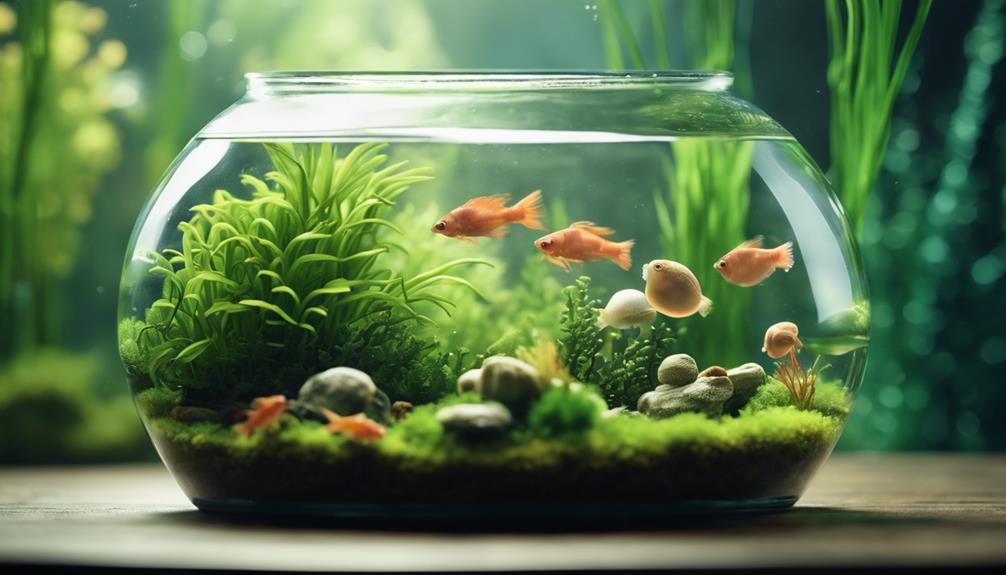
By integrating plants into an aquaponics system, you create a self-sustaining ecosystem where both plant and aquatic life thrive, reaping numerous benefits from this harmonious partnership.
As you nurture your aquatic plant species, you'll witness healthy growth, with each plant flourishing in its unique environment.
This mutually beneficial partnership allows plants to purify the water for the fish, while the fish produce waste that's converted into nutrients for the plants.
In this closed-loop system, you'll minimize water waste and utilize natural processes to maintain water quality.
By choosing the right plants, you'll optimize growth, yield, and overall health, creating a thriving ecosystem that supports both plant and aquatic life.
This innovative approach combines the benefits of aquaculture and hydroponics, allowing you to grow a diverse range of plants, from leafy greens to fruiting plants, each with their own specific nutrient requirements and growing conditions.
As you cultivate this harmonious partnership, you'll reap the rewards of a self-sustaining ecosystem, where both plants and aquatic life thrive.
Plant Options and Requirements
When selecting plants for your aquaponic system, you'll need to ponder their specific requirements to guarantee a thriving ecosystem.
You'll want to think about the nutrient demands of your chosen plants, as well as their preferred pH and temperature ranges.
Plant Nutrient Demands
Considering the unique demands of your aquaponic system, choosing the right plants is crucial, as different species have varying requirements for ideal growth and thriving.
You'll find that plants require different levels of nutrients to absorb and process effectively. Leafy greens like lettuce, kale, and spinach have low nutrient requirements, making them perfect for beginners.
On the other hand, fruiting plants like tomatoes, peppers, and cucumbers have higher nutrient demands and are better suited for larger systems with more mature ecosystems.
When selecting plants, consider their specific nutrient needs. For instance, tomatoes require a high nutrient supply to produce a bountiful harvest, while radishes need a high nutrient supply to grow quickly and healthily.
Plants with robust root systems, such as kale, are well-suited for anchoring themselves within the grow beds and can tolerate a wide range of water conditions.
Ph Considerations Matter
You'll need to carefully ponder the pH requirements of your plants, as even slight deviations can substantially impact their growth and health in your aquaponic system. Aquarium plants have specific pH needs, and selecting plants with similar requirements can simplify your system's maintenance.
Tomatoes, Peppers, and Cucumbers thrive in a pH range of 5.5-6.5, making them a great combination for your aquaponic system.
Beans are another option, tolerating a slightly wider pH range of 5.5-7.
Radishes are also a great choice, requiring a pH between 6.0 and 7.0.
Temperature Ranges Vary
As you design your aquaponic system, it's vital to factor in the varying temperature requirements of different plants to guarantee ideal growth and health.
You'll need to ponder the temperature range that each plant flourishes in, as it directly impacts their growth rate. For instance, tomatoes require a temperature range of 65°F-85°F, while peppers prefer temperatures between 60°F-75°F. Cucumbers, another warm-season crop, also thrive in the 60°F-75°F range. Beans, with their high nutrient requirement, do best between 71°F-78°F, and radishes, with their high nutrient requirement, grow quickly in temperatures between 60°F-80°F.
When selecting plants for your system, ponder the temperature range of each species and group them accordingly. This facilitates that the water column maintains a perfect temperature for all plants, promoting healthy growth and preventing stress.
Seeds and Maintenance Essentials
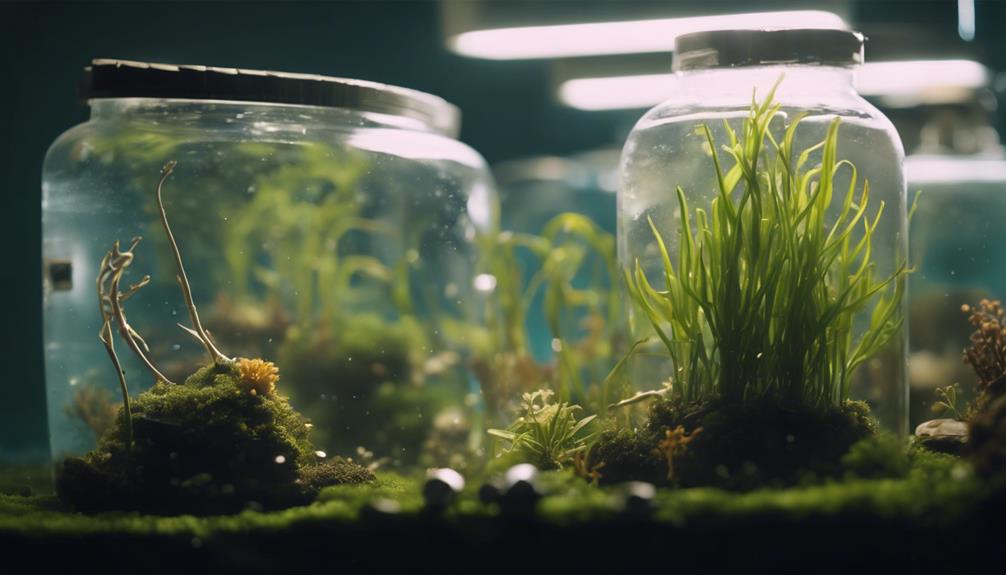
To establish a thriving aquaponic system, sourcing high-quality seeds from reputable suppliers, such as Assorted Heirloom Garden Seed Packet and Survival Vegetable Seeds Garden Kit, is essential.
You'll want to sow your seeds or transplant seedlings with precision, planting at the right depth and gently watering to guarantee successful germination and growth.
Monitor pH levels and nutrient concentrations: Regularly check and adjust these levels to maintain a healthy and thriving aquaponic system.
Prune and harvest: Prune dead leaves and harvest regularly to maintain plant health and promote continued growth. This is especially important for stem plants, which add oxygen and help support the root system.
Manage water quality: Regularly change 10% of your water weekly or 25% bi-weekly to maintain superior water quality and prevent toxin buildup.
Keep an eye on temperature: Guarantee your system stays within the ideal temperature range for your plants to thrive.
Environmental Requirements for Plants
As you set up your aquarium, you'll need to guarantee the water and lighting conditions are ideal for your plants to thrive.
You'll want to pay close attention to the specific requirements for water pH, temperature, and light spectrum, as well as the intensity and duration of light exposure.
Water Requirements
You'll need to guarantee your aquatic plants thrive by meeting their specific water requirements, which include a pH between 6.5 and 7.8, with a general hardness of 50-100 ppm and alkalinity of 3-8° dKH (54-140 ppm). This is vital for their survival and ideal growth.
Temperature: Most aquatic plants prefer temperatures between 74°F and 80°F, but some can tolerate temperatures as low as 68°F or as high as 86°F.
Water changes: Regular water changes are essential to maintain ideal water quality and prevent the buildup of toxins. Aim to change 10% of the water weekly or 25% bi-weekly.
Nutrient levels: Verify the water has low levels of nitrates (below 10 ppm) and phosphates (below 0.5 ppm) to promote healthy plant growth and prevent algae blooms.
Water hardness: Some aquatic plants, such as those from soft water habitats, may require softer water with lower general hardness and alkalinity levels.
Light Requirements
Having established the ideal water conditions for your aquatic plants, it's now important to ponder the light requirements that will fuel their growth and development. You'll want to provide your plants with full spectrum light, ideally between 6,500K and 8,000K, to promote healthy growth and vibrant coloration.
| Lighting Option | Description |
|---|---|
| High Output T5 Fluorescent | Intense, energy-efficient illumination |
| LED Lights | Low heat, high output, and energy-efficient |
| Low Light | Suitable for plants that thrive in shaded areas |
When it comes to light intensity, lumens per liter of water is more important than wattage. Aim for a minimum of 10-15 lumens per liter for most aquatic plants. You'll also want to maintain a consistent day/night cycle, providing 10-12 hours of light per day. Don't forget to keep your glass covers clean to guarantee maximum light penetration, and position your plants at the right distance from the light source to prevent burning or scorching. By meeting these light requirements, you'll create an ideal environment for your aquatic plants to thrive.
Nutrition and CO2 for Plants
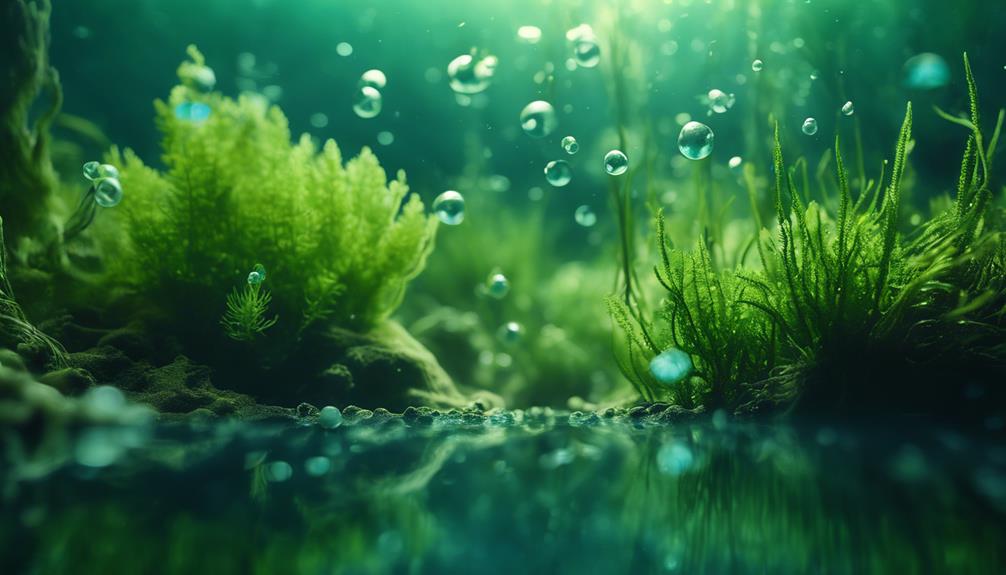
To thrive, aquatic plants require a balanced diet that includes essential nutrients like nitrogen, phosphorus, potassium, iron, magnesium, and manganese, which you can provide through a combination of fish food and waste, as well as regular mineral supplements.
When choosing plant species, it's vital to weigh their nutrient requirements. Some plants, like root-feeders, benefit from iron-rich substrates like laterite, while others absorb nutrients through their leaves.
Aqueon Aquarium Plant Food provides a convenient and effective way to supply your plants with the necessary nutrients.
Regular mineral supplements are necessary to provide essential micronutrients.
CO2 supplementation can enhance plant growth, color, and size, but isn't necessary for success.
Choose the right plant food based on your plant species' nutrient requirements.
Monitor and adjust your nutrient dosing and CO2 levels regularly to guarantee peak plant growth.
Types and Selection of Aquatic Plants
As you set out to choose the right aquatic plants for your aquarium, you'll need to ponder their growth requirements and the factors that influence their selection.
You'll want to think about the light intensity, water temperature, and pH levels your plants will need to thrive.
Plant Growth Requirements
Selecting the right aquatic plants for your aquatic life support system requires careful deliberation of their specific growth requirements and roles in maintaining a thriving ecosystem.
You'll need to ponder the water parameters, such as pH, temperature, and lighting, that your chosen plants require to flourish.
Some key growth requirements to ponder:
pH: Different plants have ideal pH ranges, so make sure to choose plants that match your system's pH level. For example, Java Fern prefers a slightly acidic pH, while growing plants like Amazon Sword tolerate a wider pH range.
Lighting: Plants have varying lighting needs, from low to high intensity. Be sure to select plants that match your system's lighting conditions.
Nutrient requirements: Plants have different nutrient needs, so choose plants that match your system's nutrient availability.
Temperature: Plants have suitable temperature ranges, so verify that your system's temperature matches the needs of your chosen plants.
Plant Selection Factors
You'll want to ponder the types of plants that thrive in your aquatic life support system, taking into account their growth habits, nutrient requirements, and space needs.
When selecting the best plants for your system, consider leafy greens like lettuce, kale, and spinach, which have low nutrient requirements and are ideal for beginners.
Herbs like basil and mint are also great options, adding flavor and charm to your system while requiring minimal nutrients.
If you have a larger system with an established fish population, fruiting plants like tomatoes, peppers, and cucumbers are a good choice, but be aware they've higher nutrient demands.
Root vegetables like carrots and beets require more space and specific conditions, but can be grown with careful planning.
When choosing plants, look for those with small roots that can thrive in a controlled environment, mimicking their natural habitat.
Plants with robust root systems, like kale, are well-suited for anchoring themselves within the grow beds of an aquaponic system.
Plant Care and Maintenance Tips
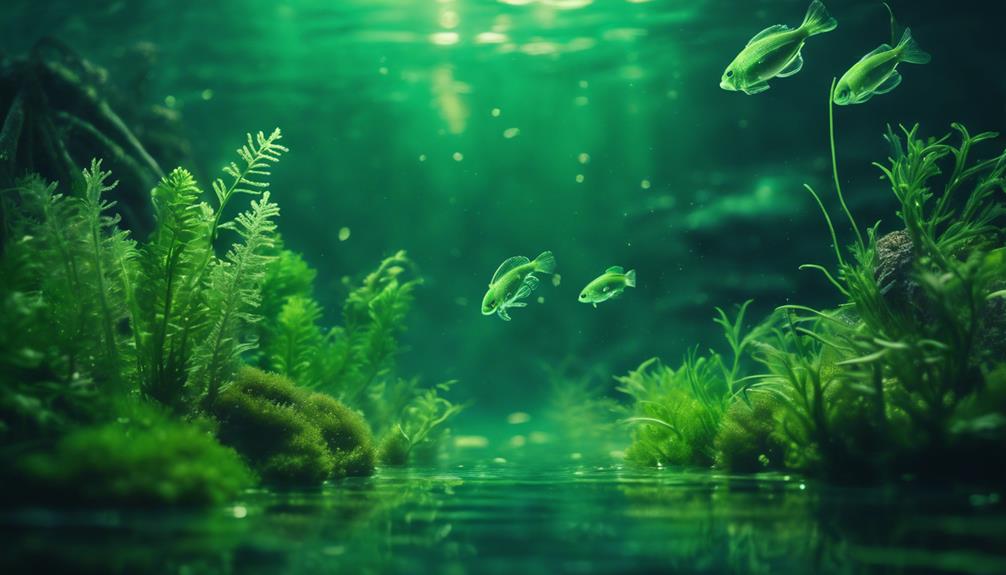
Properly caring for your aquatic plants requires attention to lighting, temperature, and nutrient levels, which can make all the difference in their survival and growth. You want to create an environment that simulates their natural habitat, and with the right care, your plants will thrive.
Monitor Lighting: Verify your plants receive the right amount of light. For example, Java Moss requires low to moderate lighting, while other plants may need more intense illumination.
Maintain Ideal Temperature: Most aquatic plants prefer temperatures between 72°F and 82°F (22°C and 28°C).
Provide Balanced Nutrients: Fertilize your plants regularly, but avoid over-fertilizing, which can harm your aquatic ecosystem.
Prune Regularly: Trim or prune your plants to maintain their shape, promote healthy growth, and prevent overcrowding.
Aquatic Plant Design and Layout
By thoughtfully designing your aquatic plant layout, you can create a thriving ecosystem that not only enhances the aesthetic appeal of your aquarium but also supports a diverse range of aquatic life.
A well-balanced freshwater aquarium should allocate 20-30% of the space to open swimming areas, 30-40% to stem plants, and 30-40% to rosette plants. This ratio creates a visually appealing and functional environment that promotes healthy water quality and oxygen production.
To add visual interest, plant aquatic plants in odd-numbered groups and vary their heights to create a natural, layered look. Incorporating plants with different leaf shapes, sizes, and colors will add depth and diversity to your ecosystem.
Consider a layered planting approach, with plants like Java moss or Anacharis on the bottom, followed by mid-water plants like Cabomba or Vallisneria, and finishing with surface plants like Water Lettuce or Water Hyacinth. This dynamic layout will support complex aquatic life and create a thriving ecosystem in your freshwater aquarium.
Easy Aquarium Plants for Beginners
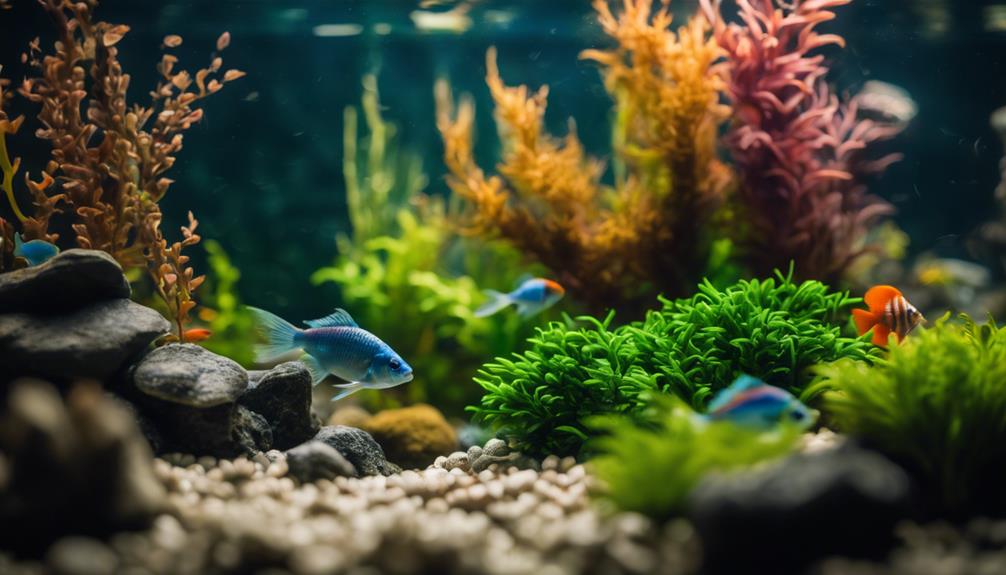
When starting your aquatic journey, choosing the right plants can make all the difference, and selecting easy-to-care-for species can help beginners build confidence and create a thriving ecosystem.
As a beginner, you want plants that are low-maintenance and can thrive in your fish tank.
Marimo Moss Ball: A unique and inexpensive plant that requires minimal maintenance and can thrive in low-light conditions.
Amazon Sword: A classic aquarium plant that requires root tabs and can grow up to 20 inches tall, making it a great choice for adding height to your tank.
Bacopa caroliniana: A good beginner stem plant option that doesn't require CO2 injection and can be grown in a variety of lighting conditions.
Java Fern: A low-maintenance plant that absorbs nutrients from liquid fertilizers and can thrive in low-light conditions, making it a great choice for a hassle-free aquarium plant.
These plants are perfect for beginners, as they're easy to care for and can thrive in a variety of conditions.
Troubleshooting Plant Issues
You'll quickly notice signs of trouble in your aquatic plants, such as yellowing leaves or stunted growth, which can signal underlying issues that need attention. To troubleshoot these problems, start by inspecting your plant's roots for signs of rot or damage, which can be caused by over-watering, poor substrate quality, or inadequate oxygen levels.
| Issue | Cause | Solution |
|---|---|---|
| Yellowing leaves | Nutrient deficiency | Adjust fertilizer dosing or CO2 injection |
| Stunted growth | Insufficient nutrient uptake | Prune and maintain plants to promote healthy growth |
| Holes in leaves | Pest infestation | Treat with insecticidal soap or neem oil, and quarantine new plants |
| Wilting stems | Water parameter deviations | Monitor and adjust pH, temperature, and hardness levels |
Regularly monitoring water parameters, such as pH, temperature, and hardness, can help prevent plant stress and illness. Additionally, maintain good aquarium hygiene and prune your plants regularly to promote healthy growth and prevent overcrowding. By addressing these common issues, you can guarantee your aquatic plants thrive and provide a healthy environment for your aquatic life.
Frequently Asked Questions
What Are the Support Systems in Aquatic Plants?
As you explore aquatic plants, you'll find their support systems include an efficient root system development, adaptive nutrient uptake strategies, and optimized photosynthetic efficiency, all working together to maintain a thriving environment.
What Plants Grow Best in an Aquaponics System?
You'll be amazed at the plants that thrive in an aquaponics system! Water Wisteria is a superstar, with its incredible nitrate uptake and fish-friendly nature. Plus, leafy greens like kale and spinach grow like crazy, making them perfect for your setup!
What Aquatic Plants Produce the Most Oxygen?
You're looking for aquatic plants that produce the most oxygen, right? Oxygen production rates depend on photosynthesis efficiency and underwater plant respiration. Cabomba and Anacharis top the list, with rates of 1.35 and 1.23 cm³/g/h, respectively, making them ideal for your aquatic setup.
What Plants Are Good for Low Tech Tanks?
You'll thrive with low-maintenance options like Java Fern, Anubius, and Dwarf Sagittaria in your low-tech tank. Consider adding Water Wisteria for a feature or green wall, and don't forget Java Moss or Floating Plants for extra oxygen and visual appeal.
Conclusion
You've now mastered the art of selecting and caring for essential plants in aquatic life support systems.
Imagine a thriving aquaponic system, where lettuce and herbs flourish above a school of tilapia, providing a constant supply of fresh produce and protein.
With the right plants and maintenance, you can create a self-sustaining ecosystem, like the successful 10,000-square-foot aquaponic farm in Milwaukee, Wisconsin, which grows over 100,000 pounds of produce annually.

